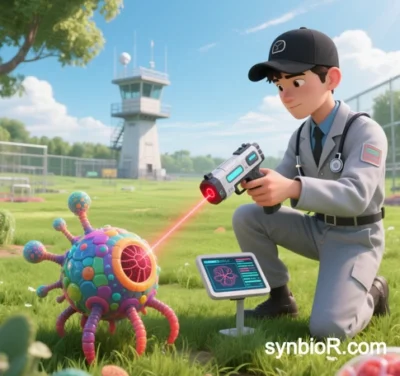
R in Synthetic Biology: Technological Integration and Innovation in Bioinformatics
The convergence of synthetic biology (SynBio) and bioinformatics, powered by the R programming language, is revolutionizing research paradigms in gene design, metabolic engineering, and systems modeling. Leveraging R’s robust bioinformatics packages (e.g., Bioconductor ecosystem), statistical modeling capabilities, and visualization tools, it has become a core platform for data-driven design and experimental validation in synthetic biology. Below are its key applications and breakthroughs across six domains:
1. Gene Design and Synthetic Genomics
Intelligent Screening of Genetic Parts
R integrates multi-omics data (transcriptomics, epigenomics) and synthetic biology databases (e.g., iGEM Registry) to predict the stability and compatibility of genetic components using machine learning models. Examples include:
- Analyzing DNA sequence GC content and codon bias with the
Biostringspackage (Bioconductor) to optimize synthetic gene translation efficiency. - Batch normalization and differential analysis of synthetic gene expression in E. coli or yeast using
tidybulkto identify high-expression promoters or terminators.
Synthetic Genome Assembly Validation
- Detecting assembly errors or structural variations in synthetic chromosomes (e.g., yeast SynIII) using
GenomicRangeswith long-read sequencing data (e.g., Oxford Nanopore). - Annotating unintended mutations (e.g., off-target edits) in synthetic genomes with
VariantAnnotationto assess CRISPR-Cas9 tool specificity.
2. Metabolic Engineering and Pathway Optimization
Metabolic Flux Modeling and Simulation
- Building differential equation models with
deSolveto simulate flux distribution in artificial pathways (e.g., terpenoid biosynthesis) and optimize enzyme ratios. - Predicting chassis cell (e.g., E. coli) growth rates post-pathway integration via constraint-based flux analysis (FBA) with
sybil.
High-Throughput Screening and Machine Learning
- Classifying phenotypes (e.g., product concentration, growth rate) from droplet microfluidics mutant libraries using
caretto train random forest models for optimal mutation prediction. - Visualizing metabolomics data with
pheatmapto identify rate-limiting steps (e.g., NADPH cofactor bottlenecks).
3. Gene Editing Validation and Quality Control
CRISPR Editing Efficiency Assessment
- Quantifying CRISPR interference (CRISPRi) or activation (CRISPRa) effects on target and off-target genes via RNA-seq analysis with
DESeq2. - Comparing sgRNA design overlap using
VennDiagramto prioritize high-specificity tools.
Single-Cell Editing Heterogeneity Analysis
- Resolving expression variability of synthetic gene circuits across cell subpopulations using
Seuratwith scRNA-seq data to optimize genetic switches (e.g., AND gate logic). - Tracking synthetic gene dynamics during differentiation via pseudotime analysis with
monocle3.
4. Systems Biology and Synthetic Gene Circuit Modeling
Dynamic Behavior Prediction of Gene Circuits
- Simulating protein concentration oscillations in synthetic oscillators (e.g., Repressilator) with
deSolveto stabilize parameters. - Constructing gene regulatory networks with
igraphto identify key nodes (e.g., positive feedback loops).
Multi-Scale Model Integration
- Coupling metabolic networks with signaling pathways using
Rxnconto predict environmental responses in engineered cell factories (e.g., photoautotrophic cyanobacteria).
5. Data Visualization and Interactive Analysis
Synthetic Biology-Specific Visualization
- Generating synthetic genome circular plots (Circos plots) with
ggbioto annotate engineered elements (e.g., biosensors, resistance markers). - Building interactive dashboards via
shinyto monitor bioreactor metabolite concentrations and growth curves in real time.
Multi-Dimensional Data Integration
- Visualizing gene expression, metabolite abundance, and phenotype data with
ComplexHeatmapto uncover global regulatory mechanisms.
6. Automated Workflows and Reproducibility
Biofoundry Data Pipelines
- Creating end-to-end automated workflows (DNA synthesis to phenotype validation) using
Snakemakeandworkflowr. - Generating reproducible reports with
Rmarkdownto track design iterations and experimental results.
Blockchain-Enabled Collaboration
- Recording synthetic biological parts (e.g., BioBricks) usage rights and provenance with
blkchainto ensure intellectual property compliance.
Challenges and Future Directions
- AI-R Integration: Merging generative AI (e.g., AlphaFold3) with R’s statistical frameworks for protein structure-function optimization.
- Cloud and Edge Computing: Deploying large-scale synthetic genome assembly tasks on AWS or Google Cloud via
cloudbiolinux. - Ethics and Biosecurity: Screening synthetic genomes for risk sequences (e.g., toxin genes) with
BiocCheck, adhering to in vitro editing guidelines.
Case Studies
- Engineered Phage Design: Phylogenetic analysis of synthetic phage genomes with
phangornto predict host range and evade immune responses. - Microbial Carbon Fixation: Optimizing Rubisco activity in CRISPR-edited cyanobacteria using
limmafor transcriptome analysis.
Conclusion
R has evolved from a data analysis tool to a full-stack platform in synthetic biology, covering gene design, dynamic modeling, experimental validation, and ethical governance. Its strengths include:
- Deep integration with bioinformatics toolchains (e.g., Bioconductor, tidyverse).
- Flexible multi-scale modeling (from molecular dynamics to population behavior).
- Rapid iteration driven by open-source ecosystems (e.g., CRISPR toolkit updates).
As synthetic biology advances in complexity and precision, R will remain indispensable in automated experimental design and AI-driven evolution.
Data sourced from public references. For collaborations or domain inquiries, contact: chuanchuan810@gmail.com.



